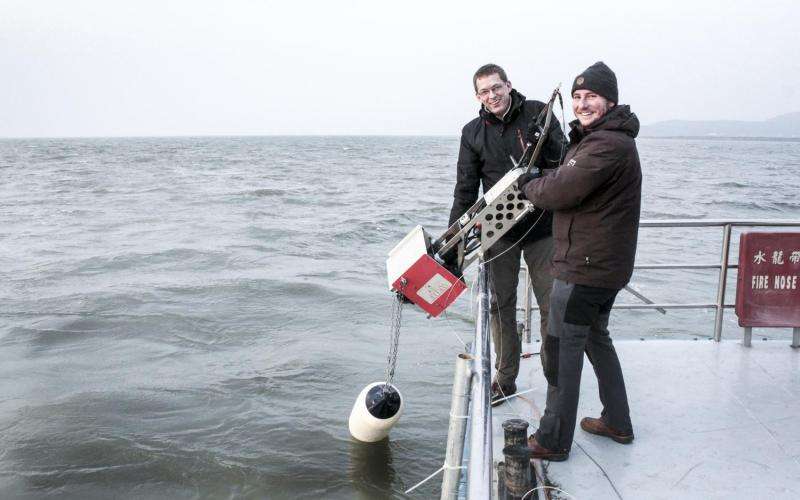Removing organic pollutants, nutrients, and heavy metals from Lake Tai

Under the "SIGN – Clean Water from the Source to the Consumer" project, Chinese and German partners work on improving water quality of Lake Tai. This lake supplies millions of people with drinking water, but is strongly polluted with organic pollutants, nutrients, and heavy metals. Under the SIGN project, the Environmental Mineralogy and Environmental Systems Analysis Group of Karlsruhe Institute of Technology (KIT) develops new monitoring technologies. Recently, the scientists went to China to take water samples.
The region around Lake Tai is one of the most rapidly growing regions in China. Rapid economic development results in an increasing consumption of process and drinking water. Lake Tai, the third biggest freshwater lake in China of 2250 km² in size, is the drinking water source for about 10 million people in China. Due to industrial and agricultural activities, however, the water is highly polluted with organic substances, nutrients, such as nitrogen and phosphorus, and heavy metals. In the past years, bad raw water quality repeatedly caused supply problems. In 2007, strong cyanobacteria growth occurred. The lake with an average depth of 2 m collapsed and water supply of the city of Wuxi was stopped for several days. Similar problems occur in other regions of China. Hence, the SIGN (Sino-German Water Supply Network) project is of model character.
"SIGN – Clean Water from the Source to the Consumer" is aimed at improving water quality and, hence, the quality of life of people living near Lake Tai. The focus lies on the megacities of Wuxi and Suzhou. SIGN covers the complete water cycle from urban wastewater and rainwater management to monitoring and early warning systems, to pollution reduction, drinking water processing and drinking water distribution, to further education and commercialization, to recommendations relating to water processing and resources management. The joint project funded by the Federal Ministry of Education and Research (BMBF) with a total of EUR 3 million started in April 2015 and has a duration of three years. Fifteen partners of German research and industry, including KIT, and ten Chinese science institutions, authorities, and waterworks participate. The project is coordinated by Professor Andreas Tiehm and Dr. Kathrin Schmidt of the DVGW-Technologiezentrum Wasser (TZW, German Water Centre), Karlsruhe.
In late November / early December 2015, scientists of the Environmental Mineralogy and Environmental Systems Analysis Group of KIT traveled to the region of Lake Tai in order to make measurements and take water samples from the lake and the renaturation zones in the shore area. For four days, the group of several German and Chinese project partners traveled the northern part of Lake Tai with a research ship of the Nanjing Institute of Geography and Limnology (NIGLAS) of the Chinese Academy of Sciences (CAS). "According to studies performed so far, this part of the lake has the highest pollution," Andreas Holbach says.
The Environmental Mineralogy and Environmental Systems Analysis Group of KIT headed by Professor Stefan Norra is in charge of the DYNAQUA (Dynamics of Water Quality) partial project of SIGN. The scientists develop, assess, and use new monitoring technologies to study spatial and temporal variations of water quality. During the stay in China, the BIOFISH sensor system adapted to shallow water was used for the first time. The system was initially developed for an earlier project on the Yangtze River and has now been adapted to the special conditions of Lake Tai, i.e. to the shallow water and the frequently encountered cyanobacteria that form various toxic substances and considerably limit water use. BIOFISH measures various chemical and physical parameters at the depth selected and records these data with a high temporal and spatial resolution. Among the parameters measured are temperature, pH, electric conductivity, photosynthetically active radiation, turbidity, and concentrations of organic substances, oxygen, chlorophyll a, and other substances.
In addition, BIOFISH is equipped with a sampling system that can be controlled automatically from the ship. Now, the water and sediment samples taken are being analyzed for nutrients, heavy metals, and organic substances as well as for the ratios of stable isotopes and pollutant-reducing microorganisms. The Environmental Mineralogy and Environmental Systems Analysis Group of the Institute of Applied Geosciences (AGW) and the Institute of Geography and Geoecology (IfGG) of KIT is responsible for nutrient and heavy metal analysis. TZW analyzes the samples for pollutant-reducing microorganisms.
Within the framework of SIGN, scientists of KIT also develop a new buoy for selective and long-term observation of stratification conditions in the water body and meteorological impacts. "The results obtained from measurements with BIOFISH and the buoy will be related to the pollutant concentrations measured in the water and sediment samples to derive environmentally relevant processes in the water of Lake Tai," Professor Stefan Norra explains. Another objective of the DYNAQUA partial project is to develop measures to improve water quality. In addition, scientists study the efficiency of renaturation in some shore areas. Artificially cultivated wetlands are to take over the function of the original vegetation and to retain or decompose pollutants.
Provided by Karlsruhe Institute of Technology





















